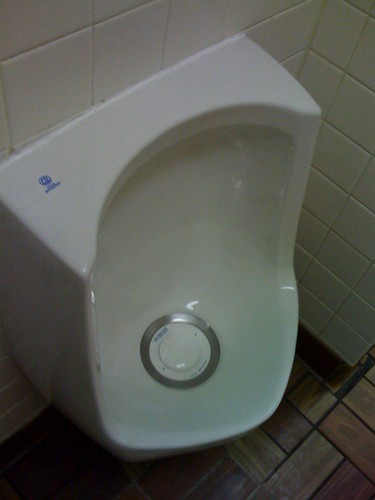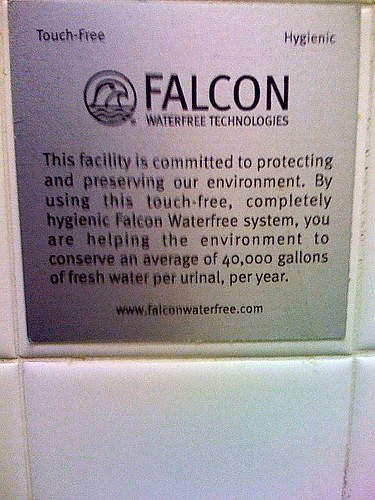Here’s a reality we deal with all the time: toilets that use a great deal of clean, potable water in order to flush. This urinal for instance, requires one gallon, or 3.8 litres, just to flush some pee, which seems excessive:
The sustainability problem here has multiple facets: the availability of water, the financial cost of water for the building owner, and the energy needed to treat and transport water, just to name three. The latter challenge alone makes up a large percentage of every city’s energy expenditure.
Let’s say we were a toilet manufacture responsible for a great deal of this water use. How might we develop concepts to address this problem? Here’s how I would use two tools from the concept design toolbox:
The problem we’re trying to address here is very clear (as opposed to, say, create a toilet that people are more likely to buy). So we can play with idealized design to set our bar very high for solving this particular problem. A ideal design statement is:
A urinal which uses no potable water at all.
Then the team could play question the brief on this statement to generate variations. Here’s a few:
- A urinal which uses greywater.
- A urinal which flushes with something other than water
- A urinal which does not use water
- A receptacle that accepts urine that is not a urinal
…and so on. Then the team could take each of these statements and workshop them, sketching and sharing and playing with ideas. Each different set of constraints helps us think differently and generate different ideas, for example the first could have us thinking of all sorts of ways of capturing and routing greywater.
We could probably generate several plausible concepts using this combination of idealized design and question the brief. One of those might be the Falcon Waterfree urinal.
And a little PR doesn’t hurt…



Comments
4 responses to “Reverse-Engineered Concept: Waterfree Toilets”
I noticed the gallon per flush indicated on an american standard the other day at a highway rest stop. “A little excessive” is a polite way of putting it. I felt awful pulling the handle. Then, a few days later I was at the facilities management office at Johns Hopkins University and noticed the Falcon Waterfree system. Apart from the obvious environmental benefits, installing a waterfree system also makes a pretty big statement about where your priorities as an organization lie. Better than a paper-printed PR campaign for sure.
I think it’s great that you are addressing the issue of water availability through design!
You should check out Carolyn Schaeberle, an Industrial Design graduate whose work, “Beyond the Tap,†has developed innovative ways for improving water transport and maintenance in developing countries. Carolyn, and other sneak peeks from the Pratt Show on May 12-15th, can be found on our blog, Pratt Success! http://prattsuccess.blogspot.com.
Thanks! Annie
Pratt Institute, Brooklyn, NY
peer@pratt.edu
I remember in high school reading about waterless toilets that used bacteria to decompose waste. Sounds gross, but they were pretty ahead of their time. The Clivus Multrum waterless toilet was one such design, if I recall correctly. Great way to make a huge impact on the environment with design.
[…] Noise Between Stations ” Reverse-Engineered Concept: Waterfree Toilets […]